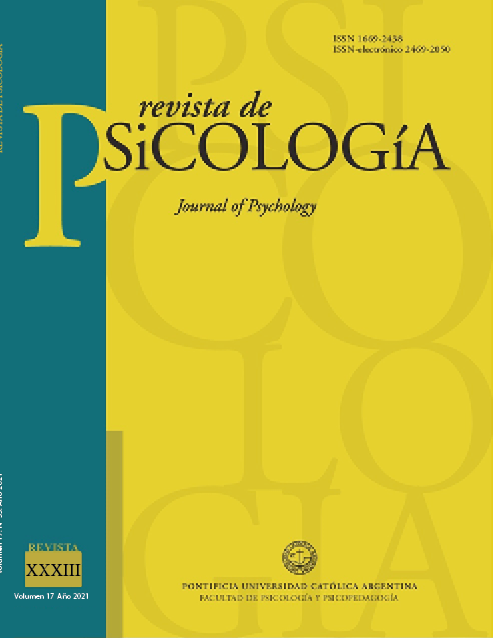Argentine version of the Monash scale for the evaluation of the owners' relationship with their dogs (MDORS-AR) and analysis of the demographic factors associated with its results
DOI:
https://doi.org/10.46553/RPSI.17.33.2021.p7-21Keywords:
Human-animal bond, Attachment, Dog-human interaction, emotional closeness, Pet-ownership perceived costs.Abstract
The dogs-owners’ relationship Monash scale, which evaluates the owner's perception of the bond with his dog, is a widely used tool in the studies about dog human interactions. The objective of this work was to validate a Spanish version of the scale with an Argentine population. To this end, the scale was administered together with a demographic survey, both through the Internet and face-to-face, to 1703 people. First, we found evidence that confirm the three components’ factor structure of the original scale. Secondly, we found that the administration form influences the results. Since people who responded online reported being emotionally closer to their dogs and perceived its maintenance as less than those who answered in person. Third, there were several associations between dog and owner’s characteristics and the scores of the scale: people who live alone interact more with their dogs, those without children reported greater interaction and emotional closeness, castrated and female dogs are perceived as more costly and people who own a dog for longer time feel emotionally closer to them even though they interact less whit their dog. In conclusion, the present version of the scale is a valid and sensitive tool to detect individual differences regarding the owners' perception of the relationship with their dogs.
Downloads
References
Bennett, P. C., & Rohlf, V. I. (2007). Owner-companion dog interactions: Relationships between demographic variables, potentially problematic behaviours, training engagement and shared activities. Applied Animal Behaviour Science, 102(1–2), 65–84. https://doi.org/10.1016/j.applanim.2006.03.009
Bowling, A. (2005). Mode of questionnaire administration can have serious effects on data quality. Journal of Public Health, 27(3), 281–291. https://doi.org/10.1093/pubmed/fdi031
Couper, M. P. (2000). Web surveys: A review of issues and aproaches. Public Opinion Quarterly at University of Georgia On, 64, 464–494.
Diaz Videla, M., & Olarte, M. A. (2017). Dogs ’ Demographic Characteristics Associated with Relationship Differences Perceived by the Guardian, European Scientific Journal. 6, 218-232.
Diaz Videla, M., & Olarte, M. A. (2016). Animales de compañía, personalidad humana
y los beneficios percibidos por los custodios. PSIENCIA Revista latinoamericana de ciencia psicológica, 8(2), 1–19. https://doi.org/10.5872/psiencia/8.2.21
Dotson, M. J., & Hyatt, E. M. (2008). Understanding dog-human companionship. Journal of Business Research, 61(5), 457–466. https://doi.org/10.1016/j.jbusres.2007.07.019
Dwyer, F., Bennett, P. C., & Coleman, G. J. (2006). Development of the Monash Dog Owner Relationship Scale (MDORS). Anthrozoos, 19(3), 243–256. https://doi.org/10.2752/089279306785415592
Dzik, V., Barrera, G. & Bentosela, M. (2018) La importancia de la oxitocina en el vínculo entre perros y personas. Interdisciplinaria. Revista de Psicología y Ciencias Afines. Interdisciplinaria, 35[2], 527-542.
Friedmann, E., & Son, H. (2009). The Human-Companion Animal Bond: How Humans Benefit. Veterinary Clinics of North America - Small Animal Practice, 39(2), 293–326. https://doi.org/10.1016/j.cvsm.2008.10.015
González-Ramírez, M. T., Vanegas-Farfano, M., & Landero-Hernández, R. (2017). Versión mexicana de la escala Monash de relación del dueño con su perro (MDORS- M). Alternativas En Psicología, 107–123. Retrieved from http://www.alternativas.me/26-numero-37-febrero-julio-2017/149-version-mexicana-de-la-escala-monash-de-relacion-del-dueno-con-su-perro-mdors-m
Grandcolas, U., And, R. R., & Marusenko, K. (2003). Ursula Grandcolas , Ruth Rettiei and Kira Marusenko Web Survey Bias : Sample or Mode Effect ? Journal of Marketing Management, 19(Couper 2000), 541–561.
Handlin, L., Nilsson, A., Ejdebäck, M., Hydbring-Sandberg, E., & Uvnäs-Moberg, K. (2012). Associations between the psychological characteristics of the human-dog relationship and oxytocin and cortisol levels. Anthrozoos, 25(2), 215–228. https://doi.org/10.2752/175303712X13316289505468
Heerwegh, D., & Loosveldt, G. (2008). Face-to-face versus web surveying in a high-internet-coverage population: Differences in response quality. Public Opinion Quarterly, 72(5), 836–846. https://doi.org/10.1093/poq/nfn045
Howell, T. J., Toukhsati, S., Conduit, R., & Bennett, P. (2013). Do dogs use a mirror to find hidden food? Journal of Veterinary Behavior: Clinical Applications and Research, 8(6), 425–430. https://doi.org/10.1016/j.jveb.2013.07.002
Marinelli, L., Adamelli, S., Normando, S., & Bono, G. (2007). Quality of life of the pet dog: Influence of owner and dog’s characteristics. Applied Animal Behaviour Science, 108(1–2), 143–156. https://doi.org/10.1016/j.applanim.2006.11.018
O’Haire, M. (2010). Companion animals and human health: Benefits, challenges, and the road ahead. Journal of Veterinary Behavior: Clinical Applications and Research, 5(5), 226–234. https://doi.org/10.1016/j.jveb.2010.02.002
Odendaal, J. S. J., & Meintjes, R. A. (2003). Neurophysiological correlates of affiliative behaviour between humans and dogs. Veterinary Journal, 165(3), 296–301. https://doi.org/10.1016/S1090-0233(02)00237-X
Polheber, J. P., & Matchock, R. L. (2013). The presence of a dog attenuates cortisol and heart rate in the Trier Social Stress Test compared to human friends. Journal of Behavioral Medicine, 37(5), 860–867. https://doi.org/10.1007/s10865-013-9546-1
Rehn, T., & Keeling, L. J. (2016). Measuring dog-owner relationships: Crossing boundaries between animal behaviour and human psychology. Applied Animal Behaviour Science, 183, 1–9. https://doi.org/10.1016/j.applanim.2016.07.003
Rehn, T., Lindholm, U., Keeling, L., & Forkman, B. (2014). I like my dog, does my dog like me? Applied Animal Behaviour Science, 150, 65–73. https://doi.org/10.1016/j.applanim.2013.10.008
Rohlf, V. I., Bennett, P. C., Toukhsati, S., & Coleman, G. (2012). Beliefs underlying dog owners’ health care behaviors: Results from a large, self-selected, internet sample. Anthrozoos, 25(2), 171–185. https://doi.org/10.2752/175303712X13316289505341
Sheppard, G., & Mills, D. (2002). The Development of a Psychometric Scale for the Evaluation of the Emotional Predispositions of Pet Dogs Journal Issue. International Journal of Comparative Psychology, 15, 201–222. Retrieved from papers://eba95c07-21c6-4247-a2f7-57339f1ca15a/Paper/p11868
Tabachnick, B.G., & Fidell, L.S. (2013). Using Multivariante Statistics, 6th Edition, Pearson.
Thorn, P., Howell, T. J., Brown, C., & Bennett, P. C. (2015). The canine cuteness effect: Owner-perceived cuteness as a predictor of human–dog relationship quality. Anthrozoos, 28(4), 569–585. https://doi.org/10.1080/08927936.2015.1069992
Van Herwijnen, I. R., Van Der Borg, J. A. M., Naguib, M., & Beerda, B. (2018). The existence of parenting styles in the owner-dog relationship. PLoS ONE, 13(2), 1–14. https://doi.org/10.1371/journal.pone.0193471
Downloads
Published
How to Cite
Issue
Section
License



















